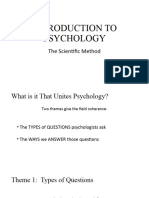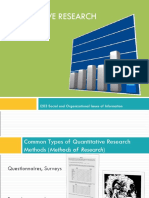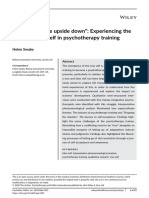Psychchap 2
Uploaded by
api-368147152Psychchap 2
Uploaded by
api-368147152Unit 2 Page 1
Unit 2 Quantitative Research Methods
Experiment- its goal is to determine whether a cause-and-effect relationship
exists between two variables.
o Experiments are an example of quantitative research methods, which
generate numerical data.
o Independent Variable- the variable that the researcher deliberately
manipulates.
o Dependent Variable- the variable measured after the manipulation of
the independent variable.
o Control- meaning that when the researcher manipulates a variable, all
other possible variables stay the same.
o Laboratory experiments allow the researcher to control the
extraneous variables- (also called confounding variables) are
undesirable variables that influence the relationship between the
independent and dependent variables. However, if we control a
situation in an experiment, it may not reflect what happens in real
life= low ecological validity.
Characteristics of experiments
o Both variables must be operationalized- written in a way where it is
clear what is being measured.
o They should be highly standardized- the procedures are written with
enough detail so that other researchers can easily replicate it.
o It should randomly allocate participants to conditions, meaning that
they have the same chance to be assigned to the control group or the
experimental group.
Hypotheses
o Research question=aim of the study
o Hypothesis- a prediction of how the independent variable will affect
the dependent variable.
o Different types of hypotheses:
Experimental hypothesis- predicts the relationship between the
IV and the DV.
Example: Listening to dissonant rock music played at
100 decibels will decrease the number of words that
adolescent girls are able to recall from a list of 30 words.
Unit 2 Page 2
Null hypothesis- states that the IV will have no effect on the
DV, or that any change in the IV will be due to chance.
Example: Listening to dissonant rock music played at
100 decibels will have no significant effect on adolescent
girls ability to recall words from a list of 30 words; any
change in the individuals ability to recall a list of words
is due to chance.
o The researcher wants to reject the null hypothesis
to show the cause- and-effect relationship exists.
o Psychologists never approve anything, they can
only disapprove.
Field experiment- the studies we do outside of a laboratory.
o Down sides to field experiments
Cannot control extraneous variables
Cannot be replicated easily
Ethical Problems
Consent; it isnt practical to get informed consent. The
general rule is people may be observed in public places
where they would expect to be observed by others.
Debriefing; its nature makes it impossible to explain
what just happened to the unwary participants.
Just like with laboratory experiments, it is important that
an ethics board approves any field experiments in order
to guarantee the protection of participants.
Quasi and Natural Experiments- in both, participants are NOT randomly
allocated to conditions. Quasi and natural experiments do not show direct
causation, but they are able to imply a causal relationship between an IV and
a DV.
o Quasi experiments- participants are grouped together based on a trait
or behavior.
Examples: Having two groups attempting to memorize a list or
words. One group is made up of people who have been
diagnosed with depression and the other group, the control,
would not have such a diagnosis. As the variable that we want
to study - having clinical depression - cannot be randomly
assigned, this study is a quasi experiment. Other typical
Unit 2 Page 3
examples of IVs used in quasi experiments include gender,
culture and age.
o Natural experiments- an independent variable that is environmental
in nature and outside of the control of the researcher. Most natural
experiments work on a pre-test, post-test design - that is, behavior is
measured both before and after the variable was introduced.
Example: In 2017 the Czech Republic in introducing a smoking
ban in all bars, restaurants and workplaces. Researchers may
decide to measure the level of clinical depression in the city of
Prague before the ban is put in place and then again six months
after the ban is in place.
Evaluating experiments- What effects their results?
o Extraneous variables
o Demand characteristics- when participants act differently because
they know that they are in a study.
o Researcher bias- when the experimenter sees what they are looking
for. In other words, the expectations of the researcher consciously or
unconsciously affect the findings of the study.
To avoid this, use double blind control- not only do the
participants not know whether they are in the experimental or
control group, but the person carrying out the experiment does
not know the aim of the study, nor which group is the treatment
and which one the control group.
o Participant variability- a limitation of a study when characteristics
of the sample affect the dependent variable.
This can be controlled for by selecting a random sample and
randomly allocating the participants to the treatment and control
groups.
o Artificiality- when the situation created is so unlikely to occur that
one has to wonder if there is any validity in the findings.
Correlational studies- when an experiment cannot be carried out, but data
is collected to show a correlation between two variables. The principle in a
correlational study is that when one variable changes, the other variable
changes as well.
o Positive correlation- when both variables are affected in the same
way. As x increases, y increases.
Unit 2 Page 4
Example: the more hours you spend studying, the better you do
on exams; or the fewer hours you spend studying, the less well
you do on exams.
o Negative correlation- as one variable increases, the other decreases.
Example: as the number of hours watching television
increases, exam scores decrease.
o Because no independent variable is manipulated, no cause-and-effect
relationship can be determined.
Example: a researcher could study the average number of hours
that a child watches television and the child's level of
aggression. The researcher might find that as the number of
hours of television viewing increased, so did the level of
aggression in the child. This would be a positive correlation.
Did television viewing cause the aggression or did aggression
lead to watching television? This is called bidirectional
ambiguity. It could also be that there is no cause-and-effect
relationship at all, but that another variable might be
responsible for the behavior.
You might also like
- Experimental Pyschology: Experimental MethodsNo ratings yetExperimental Pyschology: Experimental Methods11 pages
- Lecture 1 PSY101L, Theoretical Concepts of ExperimentNo ratings yetLecture 1 PSY101L, Theoretical Concepts of Experiment12 pages
- Intro To Experiments - Ananya Singh 1065No ratings yetIntro To Experiments - Ananya Singh 106530 pages
- FILE WORK - PRACTICALS TERM 2 - Google Docs (1)-mergedNo ratings yetFILE WORK - PRACTICALS TERM 2 - Google Docs (1)-merged28 pages
- Research methods and Psychology StatisticsNo ratings yetResearch methods and Psychology Statistics76 pages
- PSY 101L: Introduction To Psychology LabNo ratings yetPSY 101L: Introduction To Psychology Lab56 pages
- Lecture 1 Introduction To Exp Psy 11092024 020809pmNo ratings yetLecture 1 Introduction To Exp Psy 11092024 020809pm15 pages
- Chap 5 - Introduction to Experimental ResearchNo ratings yetChap 5 - Introduction to Experimental Research5 pages
- PSY 211 UNIT 5 AND 6 GUIDE NOTES - Copy (3)No ratings yetPSY 211 UNIT 5 AND 6 GUIDE NOTES - Copy (3)8 pages
- 7 Seventh - Class - Q LQ - Research - JAVERIANANo ratings yet7 Seventh - Class - Q LQ - Research - JAVERIANA31 pages
- PR2-Common Types of Quantitative ResearchNo ratings yetPR2-Common Types of Quantitative Research20 pages
- H2: PSYC 1013 Research Methods in Psychology: Lcsmanansala2015No ratings yetH2: PSYC 1013 Research Methods in Psychology: Lcsmanansala20153 pages
- Gale Researcher Guide for: Overview of Learning and Conditioning in PsychologyFrom EverandGale Researcher Guide for: Overview of Learning and Conditioning in PsychologyNo ratings yet
- Swaby, Helen (2020) - Learning To 'Live Upside Down' - Experiencing The True and False Self in Psychotherapy TrainingNo ratings yetSwaby, Helen (2020) - Learning To 'Live Upside Down' - Experiencing The True and False Self in Psychotherapy Training15 pages
- Different Types of Business CommunicationNo ratings yetDifferent Types of Business Communication10 pages
- Mindfulness and Indian Buddhist Conceptions of Unc - 2019 - Current Opinion in PNo ratings yetMindfulness and Indian Buddhist Conceptions of Unc - 2019 - Current Opinion in P4 pages
- PDF The Shared Mind Perspectives on intersubjectivity Converging Evidence in Language and Communication Research Celcr 12th Edition Jordan Zlatev download100% (2)PDF The Shared Mind Perspectives on intersubjectivity Converging Evidence in Language and Communication Research Celcr 12th Edition Jordan Zlatev download61 pages
- Summaries of Five Teaching Perspectives PDFNo ratings yetSummaries of Five Teaching Perspectives PDF11 pages
- Examining Designs of Selected Juvenile Correctional Facilities in Nigeria A Case Study Approach PDFNo ratings yetExamining Designs of Selected Juvenile Correctional Facilities in Nigeria A Case Study Approach PDF6 pages
- Table of Specification For The First Periodic Test: MAPEH 6 (S.Y. 2018-2019)No ratings yetTable of Specification For The First Periodic Test: MAPEH 6 (S.Y. 2018-2019)21 pages
- Winter 2012 - Psyc 211 - Intro To Behavioural Neuroscience SyllabusNo ratings yetWinter 2012 - Psyc 211 - Intro To Behavioural Neuroscience Syllabus3 pages
- Pecd Checklist 3 Columns Edited For Printing100% (2)Pecd Checklist 3 Columns Edited For Printing3 pages
- Lecture 1 PSY101L, Theoretical Concepts of ExperimentLecture 1 PSY101L, Theoretical Concepts of Experiment
- FILE WORK - PRACTICALS TERM 2 - Google Docs (1)-mergedFILE WORK - PRACTICALS TERM 2 - Google Docs (1)-merged
- Lecture 1 Introduction To Exp Psy 11092024 020809pmLecture 1 Introduction To Exp Psy 11092024 020809pm
- H2: PSYC 1013 Research Methods in Psychology: Lcsmanansala2015H2: PSYC 1013 Research Methods in Psychology: Lcsmanansala2015
- Gale Researcher Guide for: Overview of Learning and Conditioning in PsychologyFrom EverandGale Researcher Guide for: Overview of Learning and Conditioning in Psychology
- Swaby, Helen (2020) - Learning To 'Live Upside Down' - Experiencing The True and False Self in Psychotherapy TrainingSwaby, Helen (2020) - Learning To 'Live Upside Down' - Experiencing The True and False Self in Psychotherapy Training
- Mindfulness and Indian Buddhist Conceptions of Unc - 2019 - Current Opinion in PMindfulness and Indian Buddhist Conceptions of Unc - 2019 - Current Opinion in P
- PDF The Shared Mind Perspectives on intersubjectivity Converging Evidence in Language and Communication Research Celcr 12th Edition Jordan Zlatev downloadPDF The Shared Mind Perspectives on intersubjectivity Converging Evidence in Language and Communication Research Celcr 12th Edition Jordan Zlatev download
- Examining Designs of Selected Juvenile Correctional Facilities in Nigeria A Case Study Approach PDFExamining Designs of Selected Juvenile Correctional Facilities in Nigeria A Case Study Approach PDF
- Table of Specification For The First Periodic Test: MAPEH 6 (S.Y. 2018-2019)Table of Specification For The First Periodic Test: MAPEH 6 (S.Y. 2018-2019)
- Winter 2012 - Psyc 211 - Intro To Behavioural Neuroscience SyllabusWinter 2012 - Psyc 211 - Intro To Behavioural Neuroscience Syllabus

























































































